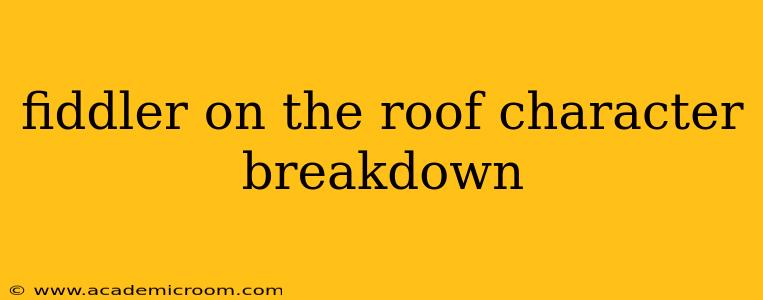Fiddler on the Roof, a beloved musical, boasts a vibrant cast of characters whose complexities and relationships drive the narrative. Understanding each character's motivations and struggles is key to appreciating the show's enduring appeal. This breakdown explores the key players, delving into their personalities, conflicts, and contributions to the overall story.
Tevye the Milkman: The Heart of the Story
Tevye is the cornerstone of the production, a poor but proud milkman grappling with tradition and modernity. He's deeply religious, clinging to his faith and the established ways of his Anatevka community. Yet, he's also a loving father wrestling with the changing times, as his daughters reject arranged marriages and seek partners based on love. His internal conflict, between his unwavering faith and his daughters' desires, creates the central dramatic tension of the entire musical. Tevye's humor, often self-deprecating, masks a deep-seated anxiety about the future and the potential loss of his cherished traditions. His famous soliloquies ("Tradition," "If I Were a Rich Man") showcase his internal turmoil and his struggle to reconcile his beliefs with the realities of his life.
Golde: The Steadfast Matriarch
Golde, Tevye's wife, is a powerful figure often overlooked. She represents the unwavering strength of tradition and the importance of family unity. While initially seemingly subservient to Tevye, she possesses a quiet strength and wisdom. Her pragmatism often contrasts with Tevye's more idealistic pronouncements, leading to humorous exchanges that also reveal the depth of their enduring marriage. While she initially supports arranged marriages, she too begins to grapple with the changing tides affecting their family and her community. Her evolution, though quieter than Tevye's, is equally significant.
The Daughters: A Generation in Transition
Tevye's five daughters represent a new generation, challenging the patriarchal structure of their community.
-
Tzeitel: The eldest, Tzeitel embodies the conflict between tradition and personal desires. She’s initially promised to the wealthy but much older Lazar Wolf, but finds love with Motel Kamzoil, a poor tailor. Her defiance of tradition shows the seeds of rebellion against the rigid social structure.
-
Hodel: The second daughter, Hodel, displays a more romantic and idealistic nature. Her relationship with Perchik, a radical student, highlights the growing influence of revolutionary ideas on the younger generation.
-
Chava: The youngest daughter, Chava, falls in love with Fyedka, a non-Jewish Russian. Her decision to marry outside the faith creates the most dramatic and heartbreaking conflict in the play, resulting in her complete ostracization from her family and community. Chava’s choice represents the ultimate break from tradition and the devastating consequences of rejecting one's heritage.
The Suitors: Reflecting the Community
The suitors for Tevye's daughters, particularly Lazar Wolf and Motel Kamzoil, also play crucial roles. Lazar Wolf represents the traditional, wealthy, yet somewhat unfeeling match that the older generation favors. Motel Kamzoil, by contrast, embodies the aspirations of the younger generation, driven by love rather than economic stability. Their contrasting personalities reflect the tension between traditional values and modern ideals.
Perchik and Fyedka: Forces of Change
Perchik and Fyedka are external forces influencing Tevye's family. Perchik, a radical student, represents the intellectual awakening and the changing social and political landscape. Fyedka, a non-Jewish Russian, symbolizes the wider world beyond Anatevka and the inevitable clash of cultures. Both men push the boundaries of tradition and challenge the established norms of the community.
The Community: A Tapestry of Life
The ensemble cast portrays the vibrant Anatevka community, with their collective experiences amplifying the themes of tradition, faith, and change. The villagers represent the strengths and weaknesses of a closely knit society facing an uncertain future.
This character breakdown only scratches the surface of the depth and complexity of Fiddler on the Roof. Each character contributes to the rich tapestry of this timeless story, making it a compelling exploration of faith, family, and the enduring power of tradition in the face of change.
